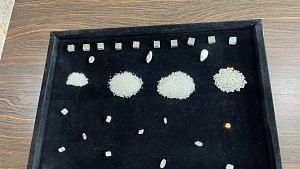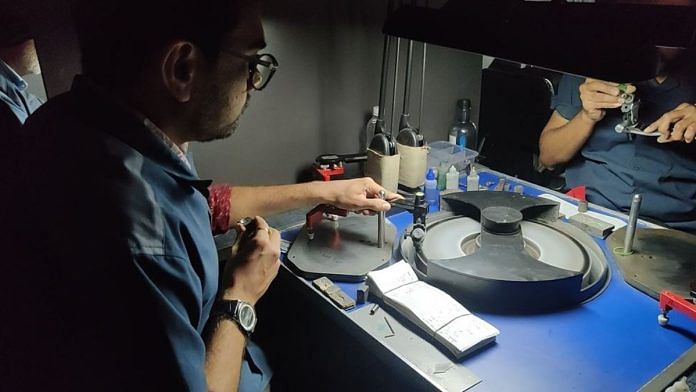There’s a new mutant on the rise in India’s oldest diamond town, Surat. And it is set to change the rules of the game.
It takes the same number of hours and workers to design and cut lab-grown diamonds, but it’s a lot cheaper, just one-tenth of the price of mined diamonds. The industry is split between the old and new, between the proven and the promised.
And India is poised perfectly in the global excitement about and demand for lab-grown diamonds. It is the market leader exporting big to the United States, the United Arab Emirates, and China. The industry’s rise began in 2018, and has grown seven times since then. As the economic slowdown exerted by the Covid-19 pandemic cascaded, India sent out lab-grown diamonds amounting to $1.3 billion in 2021-22, a 106.46 per cent increase compared to the $636.44 million trade in 2020-21.
“When we talk about lab-grown diamonds, we are talking about the diamonds of the future,” explained Sanket Patel, director of Surat-based GreenLab Diamonds, which has been dealing in growing, manufacturing, and selling lab-grown diamonds since 2018. “People want to spend, but they want to spend wisely; lab-grown diamond is an alternative to that,” said Patel, while comparing their demand to that of cultured pearls. “There used to be natural pearls and then cultured pearls [but] right now, nobody really cares about what’s natural or cultured because they are both the same – physically and optically.”

While the pop culture spin of a diamond being a “girl’s best friend” still reigns, the ‘rarity’ factor of mined diamonds might just be a thing of the past now. Much like the fashionable boom in lab-grown meat in the West, ethical consumer behaviour is a key driver in the market for lab-grown diamonds as well.
For the engineered diamond, the marketing hook lines are somewhat different from selling the ‘foreverness’ of romantic love – The ‘I know I can make an impact’ and the ‘diamond that’s made, not mined’.
Away from Surat’s bursting skylines, bustling roads and teeming millions lies Gujarat Hira Bourse, a sprawling jewellery park with companies dealing in the city’s crown jewel – the diamond.
The lush green landscape inside its palm-tree-lined compound can almost deceive visitors into thinking they’ve entered a golf course. Diamond money dazzles through its magnificent infrastructure – state-of-the-art buildings fitted with solar panels, lush gardens blooming with flowers in summer, and pools full of koi fish and water lilies.

However, a tangible element divides the diamond companies within this grand prefecture – a separation not limited to the area but touching upon every sphere where the gem exists. It’s the way a diamond is born. In Surat, the global hub of diamond manufacturing, a ballpark of companies — 5 big and 20 small ones — are in the business of making synthetic diamonds, most of which are exported abroad.
From their humble birth in the 1950s, lab-grown diamonds have grown to be embraced by big watch and jewellery companies. This includes De Beers, the iconic jewellery brand known for crafting the ever-so-popular slogan, ‘diamonds are forever’. In 2018, the company segued into the growing space through Lightbox, its manufactured diamond label. Figures emerging from India are also proof of this boom. According to the Gem Jewellery Export Promotion Council (GJEPC) – the industry’s government-backed apex body that keeps tabs on jewellery exports – India exported lab-grown diamonds worth $216.07 million in the financial year 2017-18. The latest number (between April 2022 to February 2023) stood at $1.5 billion, a seven-times rise in volume over six years.
Also read: Radio love gurus still rule in the time of Tinder, Bumble. But questions are changing
The diamonds of the future
It has been scientifically proven that the difference between mined diamonds and their lab-grown counterparts is insignificant, but the former’s ‘exquisite’ and ‘rare’ element makes the latter cheaper by a tenth of the price. Nonetheless, growers say it’s just the initial phase for these gemstones and tout low prices as a strength.
Last year, the company created a marquise step-cut diamond of 27.27 carats, calling it the world’s largest lab-grown polished diamond. GreenLab was among the first movers in the field, drawing from its five-decade experience in the mined diamond business. Patel says they decided to move toward laboratory-created stones because they were confident consumers would diversify.
It started buying lab-grown diamonds in 2016, and by the beginning of 2018, it got its own reactors to grow and cultivate them.
“We started with eight reactors in GreenLab, and now we are sitting at 1,250 reactors. In 2018, we were roughly doing about 6,000-7,000 carats of rough diamonds a month, and now we are doing 2,60,000. That’s the growth we have picked up. Obviously, it’s selling [and] that’s why we are growing,” he says, adding that seven out of 10 rings exported to the US, consist of lab-grown solitaires.
Closer home, the picture is slightly different. Patel says the share of cultivated diamonds in the Indian market is a “very, very, very small ratio” compared to traditional ones.
“People are moving forward with the change. They are going to accept it [lab-grown diamonds] but very slowly. It’s not going to be rapid speed. America has always been the trendsetter for the entire world, so what America does in six years will move down to Europe, China and then to India. So, I think it’s started to pick up,” he says.
However, there is now a looming concern for the industry. China is dumping its lab-grown diamonds in India, driving down prices. “The price dropped really drastically, but again, on the other side, the consumption increased very rapidly. But what happened is, the retailers and the wholesalers who buy in bulk got a little paranoid,” says Patel.
Also read: GreNo is Greater Noida’s new upmarket tag. It’s no more a step-sister to Noida
Growing diamonds in India
The elder among the Patel siblings, Smit, is the convener of the lab-grown diamond panel of the GJEPC. Shedding more light on the expansion of the industry, Smit remarks that the experience of cutting and polishing diamonds works as an advantage in engineered diamond production – especially in a city like Surat, which has no shortage of such artisans.
“The people who had shifted to lab-grown have already had experience,” he says, citing how his company cut and polished for 55 years before shifting to lab-grown solitaires.
While some fresh faces are also entering the field, this is the general recruitment pattern followed by existing companies. “A majority of people are already experienced in the diamond industry and are shifting because they see the potential.”
Different countries use different technologies to produce diamonds, but Smit says that the most advanced of them all – Chemical Vapour Deposition (CVD) – is being used by India.
“India is the largest grower of CVD [diamonds] today,” he said.
Sharing more data and stories of the lab-made gem’s global acceptance, he spoke about retail stores in the US keeping 33 per cent CVDs on display in 2020 – a figure that rose to 77.8 per cent by December 2022.
“We see a similar pattern in India now. A lot of regions have started opening up to lab-grown diamonds. A lot of education has taken place [and] retailers are accepting this product. So, I believe India will have the same trajectory in the coming future,” Smit adds, emphasising the ‘price-factor’ of these cultivated gems. “Affordability has enabled this product”.
Also read: Agra’s centuries-old footwear industry has a new challenge—quality control
Some accept, some oppose
Owners of mined diamond companies don’t deny the pace at which the CVD market is growing globally. But acceptance of this new entrant varies starkly in the diamond industry pyramid. While those lower in the diamond supply chain are fiercely opposed to engineered variants, big traders who deal in export-quality stones are unperturbed.
“The prices have gone down in lab-grown diamonds, but it would rather be a new industry because the customer and the target user are different. If you want to wear diamonds worth Rs 2 lakh and CVD you are getting [them] for Rs 25,000, out of 100 customers, only 10 will divert from the Rs 2 lakh to Rs 25,000 [diamonds]. Ninety will stay because they would want to wear real diamonds,” says the owner of a company dealing in big natural diamonds.
He foresees a new customer belt emerging for the product, and even though there might be a few common customers, the prospect “won’t threaten the original diamond industry”.
The outlook is, however, in stark contrast to Smit’s observation. Initially, the GJEPC convenor assumed that CVDs would be purchased only by people who couldn’t afford mined diamonds.
“But that hasn’t been true. People who are wearing mined diamonds are also converting to lab-grown diamonds,” says Smit. He adds that customers who’ve been “wearing diamonds for years” are the first to shift loyalties due to their “understanding” of gems. “Once they see this product, they see it has the exact same properties, and they shift.”
But as one moves down the diamond business hierarchy, relaxed demeanours give way to aggressive attitudes. Jatin Patel, the owner of a small diamond unit employing 40 workers, is quite hostile to CVDs.
“Natural is natural. There’s no comparison,” he says smugly.
The steep fall in engineered diamond rates makes him more apprehensive. “If the price of CVD comes down to Rs 100, this industry will not survive.”
Also read: Gita Press at 100—the cultural powerhouse made Hinduism relatable, affordable, portable
Rising animosity
The hostility toward CVD intensifies as one moves toward the last wrung of the ladder – the workers.
Sunil Rathore provides third-party polish and cutting services from a dingy floor of a rugged-looking building. It’s a far cry from the air-conditioned and high-tech environs of GreenLabs, where, according to Sanket Patel, workers are paid anything between $2,500-$45,00 a month.
At Rathore’s workshop, artisans sweat it out under fans that can hardly abate the scorching Surat heat. The comforts of air-conditioning are reserved only for the owner and those involved in planning diamond shapes on computers.

He talks about business in rupees instead of dollars. “The labourers get Rs 50 to polish a real diamond. To polish a lab-grown diamond, a worker gets Rs 35-40,” he says, highlighting the drop in labour cost.
The workers, Rathore adds, couldn’t resonate with the joy the lab-grown diamond sector experienced after the Modi government announced a big subsidy for it in this year’s budget, along with relaxed customs duty.
“The subsidy the government gives is helpful for the big businessmen, the seths (wealthy merchants) who export [diamonds]. His thoughts and our thoughts are different. We are workers. There’s no future for labourers in the lab-grown diamond industry. The trader for whom I make these diamonds told me that a one-carat lab-grown diamond previously sold for Rs 20,000 has dropped to Rs 5,000,” says Rathore, sighing with dejection.
Workers don’t have much of a choice, though. They will sparkle any rough diamond as long as there’s money involved. No questions asked.
But when a slowdown shakes the diamond industry, it is these workers who are hit the hardest. Gujarat Diamond Workers Union vice-president Bhavesh Tank is vehemently against lab-grown diamonds as workers get paid even less for the same amount of work.
“We admit that lab diamonds have slightly improved employment rates, but if we talk about the diamond industry as a whole, lots of problems may arise because of them. If production increases incessantly, what will the value of that item be? If every country in the world has the Kohinoor diamond, will it have any value?”
(Edited by Zoya Bhatti)



